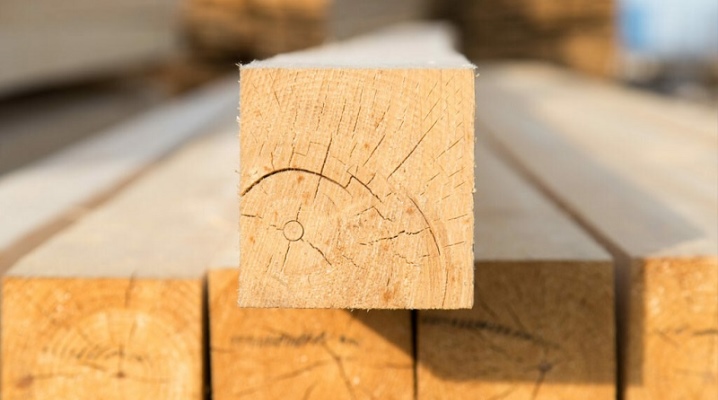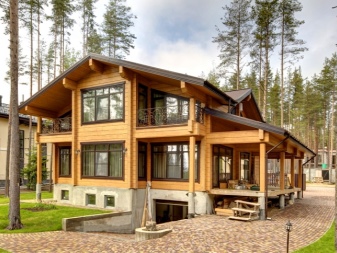How much does the timber weigh?

Glued laminated timber is a planed dried timber covered with a glue base that prevents water from penetrating into the wood fibers, causing it to swell. The volume of laminated veneer lumber - by weight - slightly differs from the usual planed one.


What does the mass depend on?
The mass of the timber is determined, like the weight of any wood, by the following factors:
- dimensions, length of timber planks;
- by drying - dry wood contains no more than 18% of water, wet - more than 45%;
- the type and structure of the tree - for example, oak and pine have different densities, even when extremely dry;
- the presence of an impregnation that somewhat makes the wood material heavier - even after the coating composition has completely dried.
The moisture content of wood is determined based on the conditions of its storage. After a year of keeping in a warehouse, where the ingress of precipitation (rain, snow, fog) and splashing water is completely excluded, the tree dries up to an average of 21%. To reduce the percentage of humidity to a minimum of 17%, create a dry and hot environment... In a hangar with steel walls and a roof in the summer heat, the temperature reaches +55, which speeds up the drying process, while in winter, in Russian conditions, an elevated temperature is additionally maintained in the warehouse. Boards and beams are placed on spacers, and air walks in the cracks formed. Silica gel can be used for moisture absorption; in order to maximize the efficiency of desiccants, the warehouse is closed tightly after airing. Artificially created conditions for dehydration of wood will prevent unnecessary standstill of wood, the appearance of mold and mildew on their surface.
Raw wood contains 24–45% moisture. It is dried from the moment of cutting (directly the workpiece) to a balanced (natural moisture) state. But wet (freshly cut), including floatable (downstream of the river), can contain up to half (by mass) of water: it is abundantly saturated with it. And for high-quality drying, it may take up to a year of storage. The total mass of the cargo requested by the customer is the weight of each stack (or boards from the stack) multiplied by the number of units (stacks, boards, respectively). The mass of cubic meters of wood is a secondary factor for the user. First of all, the actual cubic meters taken from the warehouse after payment of the order are taken into account. But the total weight is important to the manager and the driver performing the delivery: the more cubes of timber the client orders, the higher the fuel costs for the truck. Unlike slabs or other boards of an unusual shape, as well as chips, shavings, sawdust, wood dust, bark, glued beams, like a simple board or composite-wood board, are simplified in calculating the mass of a cubic meter (and a single sample of material).


The weight of the timber of different types
Freshly sawn timber, for example, larch, is equal in density to about 830 kg / m3. The volume of a wooden element, for example, 150x150x6000 (the height and width are equal, the section is square) is 0.135 "cube". Multiplying the density of the selected species (type, variety) of wood by cubic meters, we get the weight. Natural humidity - air-dry drying, equal in humidity to 19 ... 23%. For conifers, such as spruce and cedar, the density at natural moisture is exactly half a ton per 1 m3. After chamber drying, the same cubic meter of the board lightens by another 50 kg: the specific gravity will be only 450 kg / m3. In the case of a birch bar, natural moisture and chamber drying bring the weight of the "cube" to 650 and 600 kg, respectively.
The difference between non-glued and glued timber is the mass of the dry residue of the glue, the layer of which has penetrated into the wood - instead of water evaporated from the surface layers. It is easy to calculate that, having spent 30 kg of glue on a birch bar, a cubic meter of which has just been removed from the drying chamber, when dried in weight to 20 kg, the painter will achieve a cubic meter weight of 620 kg.
The fact is that the glue is well absorbed into the wood fibers (and into boards based on wood dust and shavings), without leading to a noticeable swelling of the wooden specimen.


How to calculate?
The calculation formula provides for the conversion of all quantities to meters. Millimeters indicated in the drawings must be translated into meters, otherwise the result will be unreliable. We do the following:
- we multiply the length, width and height of the board by each other;
- the resulting volume is multiplied by the standard density (taking into account humidity);
- we divide the cubic meter of the selected building material by the volume of one board or element of a bar.
The resulting value is the number of boards per "cube". This allows loaders to quickly and efficiently transfer timber from the warehouse to the truck body, spending a minimum of time. The fact is that not always the elements of the bar have a section, for example, 10 * 10 cm.No one will cut the bar into one-meter parts - mainly 2-, 4-, 6-, 10-, 12-meter specimens are used, intended immediately for construction (masonry of wooden walls, flooring, floor beams, construction of fences, benches, pillars, etc.).
In the first of the above examples, a cubic meter of bars measuring 150x150x6000 is 7 copies - with a small remainder. So, the weight of a cubic meter of dry acacia will be about 700 kg. Acacia timber in 150x150x6000 mm is equal in weight to 94.5 kg (almost a centner).
Conclusion
To calculate the cost of delivery, the wood (in this case, timber) is thoroughly dried, possibly covered with glue. Sawing glued boards is not allowed: they are already fully processed. After calculating the volume, dimensions and weight of the timber, the order will be delivered to the client.















The comment was sent successfully.